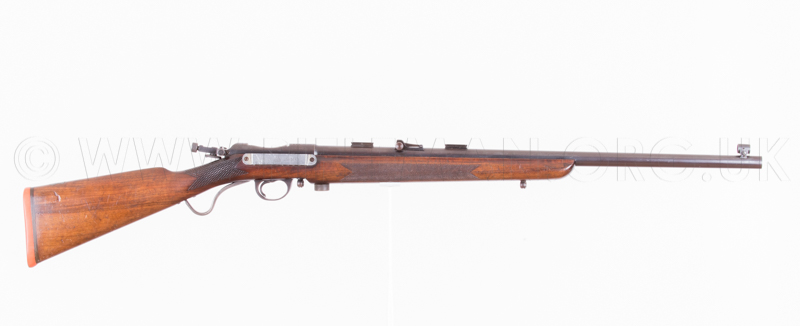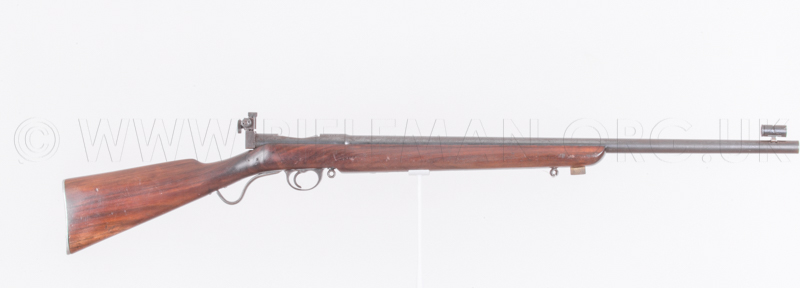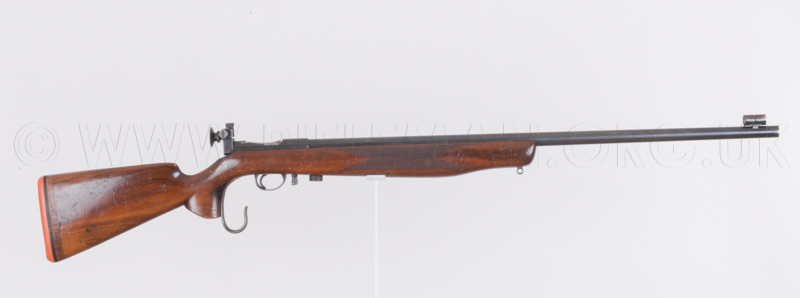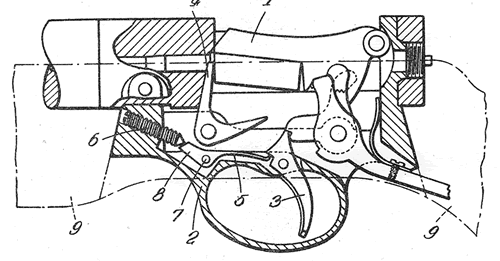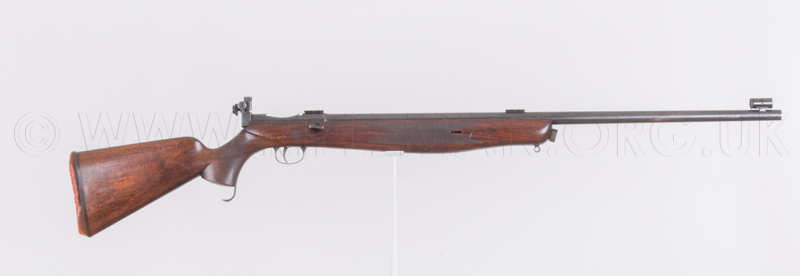Vickers Armstrong and the
THE VICKERS MARTINI TARGET RIFLES
MARKS I, II& III, plus the Standard, Empire, Champion, Jubilee and Olympic models
and the Survey Data
Please be aware that some specialist imagery may take time to load.
This site is designed for dedicated researchers, and is best viewed on desktop.
See also: ......See also the Vickers-based "WALKER" PRESENTATION RIFLE of 1935 
The Vickers Armstrong industrial giant stemmed from the foundation, in 1828, of the Sheffield steel and bronze foundry which later became Naylor, Vickers & Co.
Born in 1804, Edward Vickers, a miller, joined, at around the time of the birth of his first son, the steel firm run by his father-in-law, George Naylor. His two sons, Thomas and Albert, eventually also joined the business which, by 1867, had moved entirely into the hands of the Vickers family. The company's move into armaments came in 1897 with the acquisition of the Barrow ( in Furness) Shipbuilding company and its arms manufacturing subsidiary, the Maxim Nordenfelt concern of which Thomas had become chairman, and which company was itself a marriage of Hiram Maxim's firm, developed on his machine gun designs, and the Nordenfelt business, which produced the famous multi-barrel (four) quick-firing small-calibre cannon.
The outcome of the merger was the Vickers, Sons and Maxim company.
With this bought-in shipyard and armament capability, the company progressed, in the early part of the Twentieth Century, into one of the foremost shipbuilding and armament conglomerates. The company enjoyed huge Naval contracts, borne out of the tremendous growth of the Royal Navy, in addition to a plethora of other military procurement requirements, particularly in armour, heavy guns and, by the time of the First World War, aviation. They are, in small-arms terms, probably most well known for the notorious and effective - "Grand Old Lady of No Man's Land" - the Vickers machine gun. Collectors of more readily publicly available Vickers' production items will also know them for their versions of the No.1 bayonet for the S.M.L.E. (Short Magazine Lee-Enfield rifle).
Vickers were also involved in trials of John Pedersen's design for a semi-automatic rifle between the Wars. The British version of the rifle was made by Vickers, leading to that model the Pedersen rifle being commonly called the Vickers Rifle; but that is not the subject of this article.
Vickers' foray into the small-bore rifle arena came in the very early 1920s. By 1924 they were advertising their Mk.I target rifles and accompanying sporting versions. In 1927 the business merged yet again, this time with Armstrong Whitworth, itself an amalgamation of the interests of the well known industrialist, Sir William Armstrong, and Joseph Whitworth, (see small-bore: a definition) the famous self-taught engineer responsible for so many advances in rifle design and most of the thread and engineering standards which unified manufacture in the latter period of the industrial revolution.
The Vickers Armstrong empire was effectively broken up, between the 1960s and 1990s, into parts respectively forming into sections of, amongst other things, the nationalised British Steel Industry, the British Aircraft Corporation (latterly BAE), and Marconi - by then part of General Electric. At the end of the 'last' Century, Vicker's, who had acquired the Royal Ordnance Factory in 1986 ( now closed, and from whence the 'Enfield Pattern Room' National Firearms collection was, in 2004, removed to the care of the Leeds Royal Armouries), were taken over by Rolls Royce and ............ well, you probably know the rest.
Thomas Vickers died in 1915, having achieved significant recognition in the annals of British industry.
He had been both a Justice of the Peace and Colonel of the Hallamshire rifles.
His military interests no doubt influenced the continuing progress of the company,
which now lay in the hands of his brother Albert.
Albert himself died in 1919, shortly after the end of the First World War.
The company's works at Crayford in Kent had, very early in the Twentieth Century, built cars for the Siddeley Autocar Co., (later to become Armstrong Siddeley). Prior to WWI, Crayford also produced Wolseley motor cars under the Siddeley Autocar name. During WWI, the Crayford factories manufactured everything from the Maxim Gun, which the company had been producing from the time of the Boer War, to the Vickers Gunbus and Vimy aircraft, and a plethora of other military equipment.
After the Great War, the company was struggling to diversify with civilian products when their military contracts were dramatically reduced. Their pre-war production of sewing machines at the Hackney Wick factory was moved to Crayford and expanded at this time. Additionally, the company opted to join the fray with the Birmingham Small Arms Company, W.W. Greener and several other arms manufacturers in taking up the gauntlet on behalf of the Earl Lord Roberts who, at the beginning of the Twentieth Century, was instrumental in the encouragement of rifle-shooting within the civilian populace, and the associated formation of the Society of Miniature Rifle Clubs.
Indeed, Vickers' small-bore rifles proved, over their comparatively short production span between the early 1920s and the Second Warld War, to be highly competitive. They developed a deserved reputation for accuracy, still displayed by many of the surviving examples, although it is only fair to say that a proportion of these increasingly rare remaining rifles owe their latter-day accuracy to the post-war tender mercies of the A.G. and A.J. Parker and Parker-Hale gunsmithing companies, by dint of their "Parker-Rifling" system.
The early production was associated only with the Vickers Company, who had offices in London at Vickers House in Westminster. The Westminster address was used on those rifles made at Crayford until the company's amalgamation with Armstrongs in 1927, when the rifles' barrels were roll stamped with the "VICKERS-ARMSTRONGS" marking.
An early model, now known as the ' Mark I', Vickers Match target rifle is shown below, with chequered furniture
and its folding aperture rearsight pivoted on the rear of the action.
The barrel has been subsequently fitted with mounting blocks for a telescopic target sight.
The Mark I rifle in the 3D image below can be rotated through both axes
by dragging your cursor left to right. It can be zoomed and panned by clicking with the magnifier,
and viewed full screen using the arrows top right.
The 1925 advertisement for the early standard Mk.I and Mk.III Match rifle
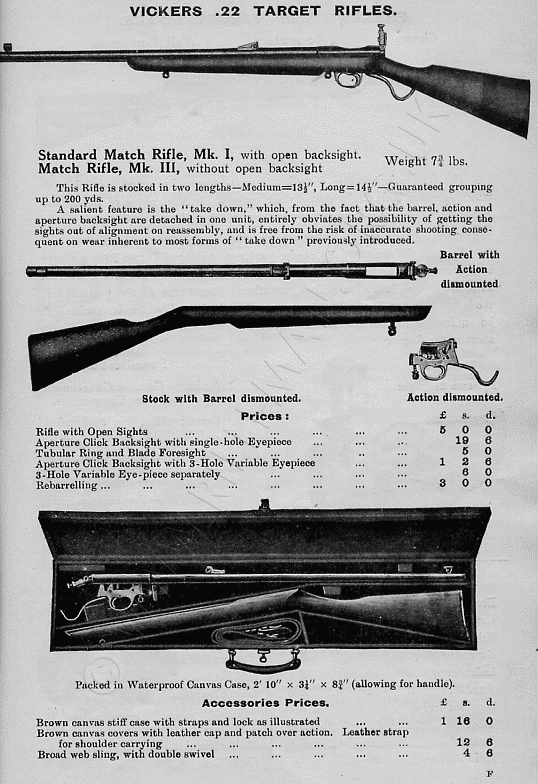
The Mark III rifle is not represented in this article other than by this catalogue page.
That rifle is simply a Mark I without the tangent leaf rear-sight on the barrel.
We suspect that few of these were sold, in view of the fact that the folding rear-sight on such a rifle
would be of limited value, as there would be no alternative sight when it was folded down.
Therefore its only purpose would be for ease of fitting into a slip or case.
Below is a facsimile of the 1920 catalogue for the Mark I rifle.
This is in the form of a text-searchable flip-page document
that may take a few moments to load.
Double tap tablet or click ![]() for full page display.
for full page display.
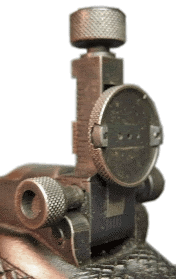
Note that the rifle was sold as being a convenient "Take-down" model along the lines of the marketing of such systems probably initiated by W.W. Greener. with his split frame converted Martini-Henry rifles and their small-frame Martini equivalents.
Left, the fore-sight is the equivalent of the BSA No.19 'flip-over' model, with which a quick change from aperture to post, or blade, element can be achieved by simply turning a side lever through ninety degrees.
Vickers produced their own barrel mounted tangent rear-sight with cammed elevation adjustment with windage incorporated in a dovetail. It is calibrated for 25, 50, 100 and 200 yards.
The folding rear-sight available on the early Mark I rifles was pivoted between two lugs which were part of the machining for the one-piece receiver. The elevation upright is almost identical to the BSA No.8 folding rear-sight.
The particular eyepiece fitted to this sight has a three-hole aperture arrangement on a horizontal slide to alter the size of the aperture required by the shooter.
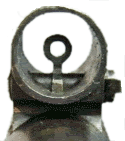 .......
....... 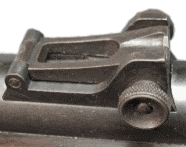 ......
......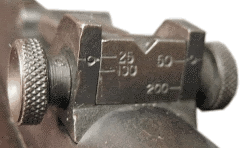
The Mark I rifle fitted with a Parker-Hale "Targetscope"

A Parker-Hale "Quickloader" ten-round ammunition block has been fitted to the stock alongside the action/receiver

The "Targetscope" was actually a renamed product imported from the U.S.A.
Any one familiar with such things will recognise it as a re-labelled Fecker 'scope.
Below left: the later standard rifle's "Special" barrel fitted with the later BSA/Parker-Hale style large-tunnel fore-sight with changeable elements, and, right: the early Mark I barrel with BSA type small diameter tunnel and flip-over ring/post fore-sight . Both barrels can be seen to be sleeved, but neither are marked as being "ParkerRifled".
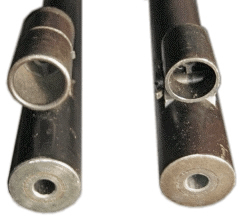
Below: the standard rifle with a "Special" barrel
The standard rifle in the 3D image below can be rotated through both axes
by dragging your cursor left to right. It can be zoomed and panned by clicking with the magnifier, and viewed full screen using the arrows top right.
A more than cursory glance at this later mark of rifle shows the non-folding "Perfection" aperture rear-sight now fixed to the rear of the action. This sight was manufactured with a hole through the machining and through the rear of the action to permit the use of a cleaning rod from the breech-end without necessitating removal of the sight.
Additionally, it should be noticed that the comb of the butt-stock is significantly higher than that of the Mark I rifle. It is not clear in the above image, but the comb has been raised by inletting a closely matching section of timber to raise the cheek height by about 20%. This appears to be a factory modification rather than a retro-fit. Many rifles have been viewed with exactly this alteration, and it is believed that the early stocks were found to be so low in the comb that a general adaptation was made to the remaining factory stock (pardon the unintentional pun).
The Mark 1 in 1st. and 2nd. grade model options are shown
in the Parker-Hale catalogue of 1933.
Note that at this point the Perfection sight is
without the elevation slide quick release button.
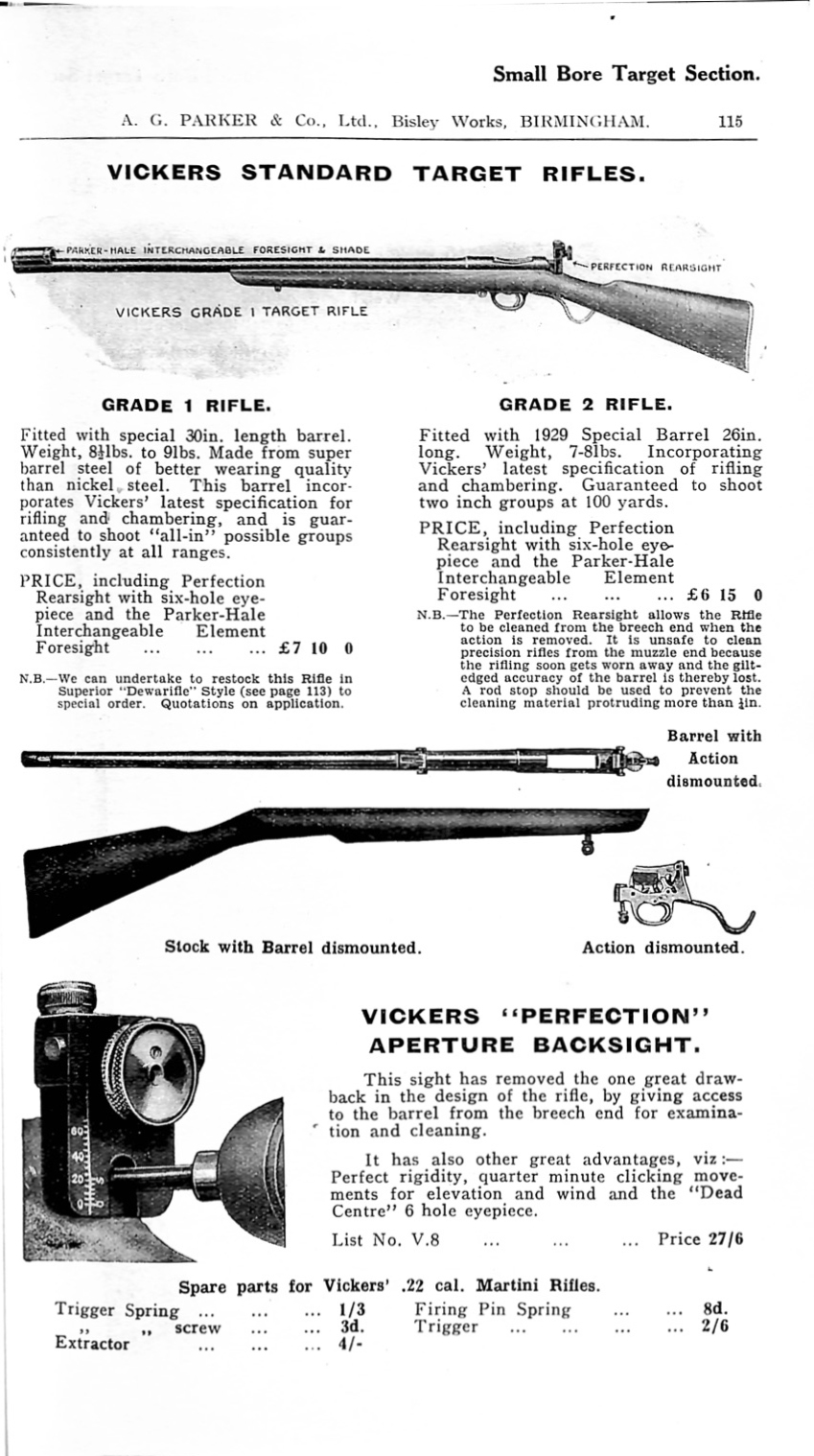
The Mark II advertised below is actually a sporting version with upgrading options - read on.
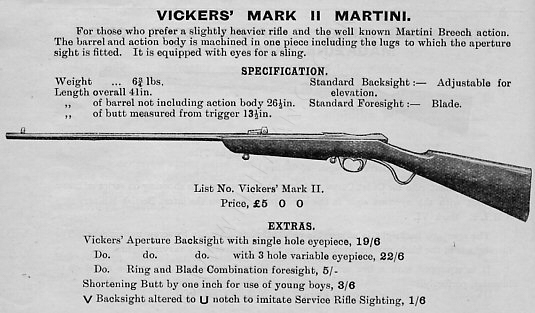
The later Mark II rifle was fitted as standard with a Perfection sight that had been improved
by the addition of a release press-button for the elevation arm,
very similar to the system used on the equivalent BSA sights.
Indeed, the sight bears a marked resemblance to the Parker-Hale PH-8 aperture rear-sight,
and may well have been either manufactured under license, or by Parker-Hale themselves,
initially under the name of "Perfection" for Vickers.
However, the double slots in the front of the sight that fit onto the lugs
at the rear of the Vickers 'receiver' body are different from other models of the sight,
and is is quite unusual to see one of these sights with "PH8" stamped on the rear above the cleaning-rod hole.
Latterly some of these sights fitted to Vickers rifles,
originally only bearing a design registration number registered design number 729116, dating to 1927-28,
were actually stamped on the RHS as being Parker-Hale products, but not marked PH8.
In the 1933 Parker-Hale catalogue these rifles are noted as the Standard models, but the top rifle is effectively the Mark II target version rather than the sporting model.
The Mark II rifle in the 3D image below can be rotated through both axes
by dragging your cursor left to right. It can be zoomed and panned by clicking with the magnifier,
and viewed full screen using the arrows top right.
The rake of the butt-stock and low comb can be observed in the last advertisement above,
whilst the let-in woodwork of the comb raiser is clear to see in the image below left.
A fine crack can just be seen starting below the rear-sight body and running downwards and forward towards the trigger-guard. This has been recognised as a common failure point on the standard stocks, and requires the earliest possible attention to prevent complete fracture of the slender woodwork ahead of the wrist.
Right, the later Perfection sight with the quick-release button for the elevation slide.
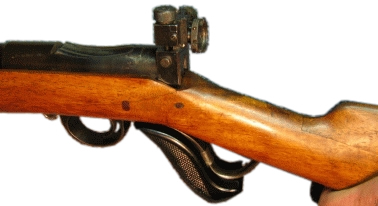 .............
............. 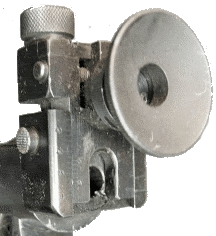
The 'Indoor' Bisley meeting was held in the famous home of the British Broadcasting Corporation at Alexandra Palace in N.W. London. From here were transmitted the first television pictures to be publicly broadcast in the U.K. The building has what is even by current standards a large hall, in which to this day many exhibitions are held each year. It was the venue for the Model Engineering exhibition for many years, and permits the indoor flying of model aircraft - but shooting has not taken place there since the War.
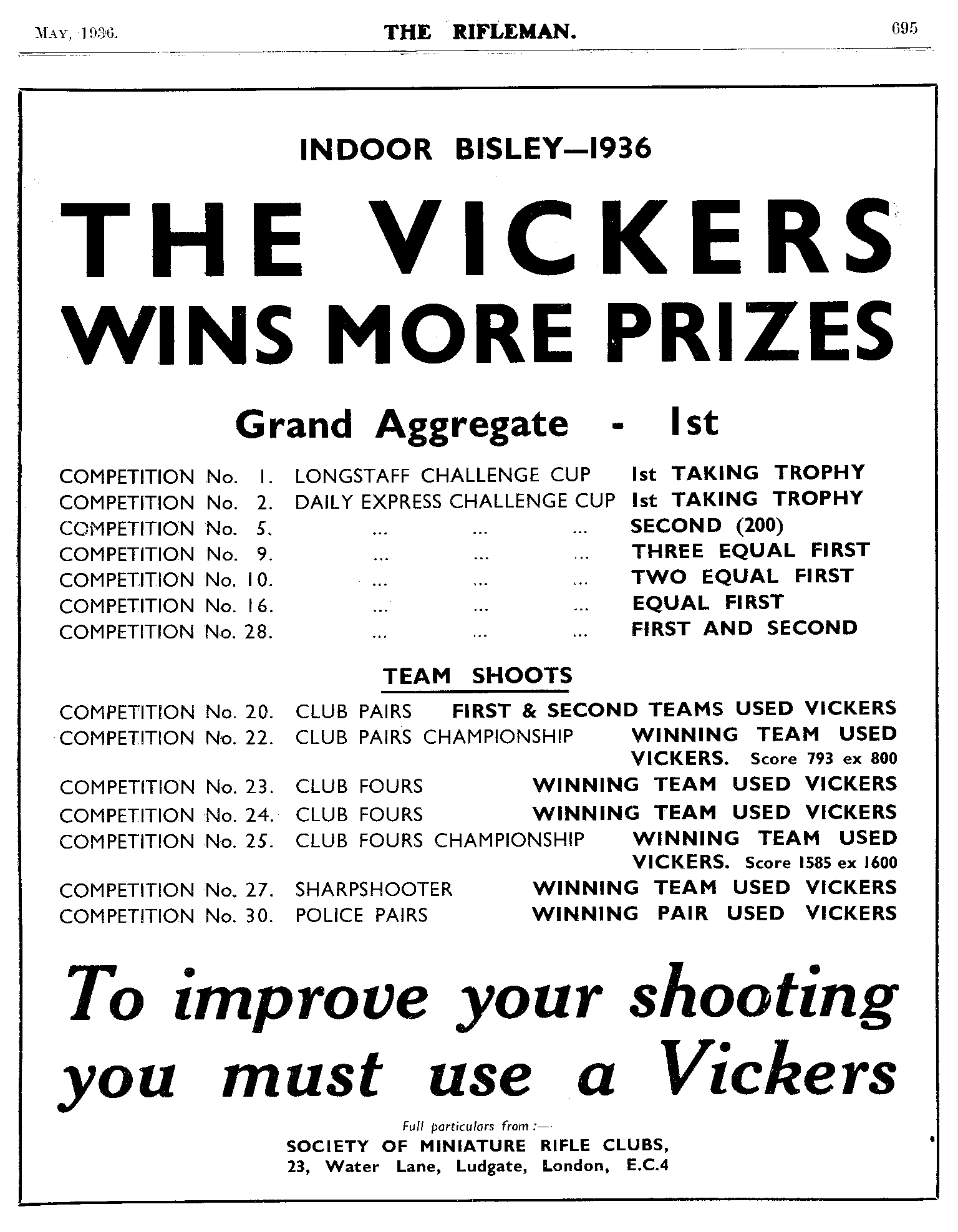
The advertisement is from a page of "The Rifleman", the monthly journal of the Society of Miniature Rifle Clubs (S.M.R.C.), and still current as the journal of what is now the U.K. National Small-bore Rifle Association (N.S.R.A.). At the time of the 'ad', in 1936, the S.M.R.C. had its headquarters at No.23, Water Lane, Ludgate in East London. Sadly, these Codrington House premises were bombed out by incendiaries in the 'Blitz' during the 1939-45 Second World War, and many of the Society's important records were lost.
The Vickers Champion is shown below, with its 'swollen' and chequered fore-end in the style of the Parker-Hale Dewar rifle.
The forward curled under-lever was also reminiscent of the Dewar, and much favoured for rapid or timed competition such as Skirmisher Shooting in which, after firing a shot, the back of the hand can push the lever forward and open the breech for reloading in one easy movement.
The "Champion" rifle in the 3D image below can be rotated through both axes
by dragging your cursor left to right. It can be zoomed and panned by clicking with the magnifier,
and viewed full screen using the arrows top right.
Below: the 1933 advertisement for the "Champion" model
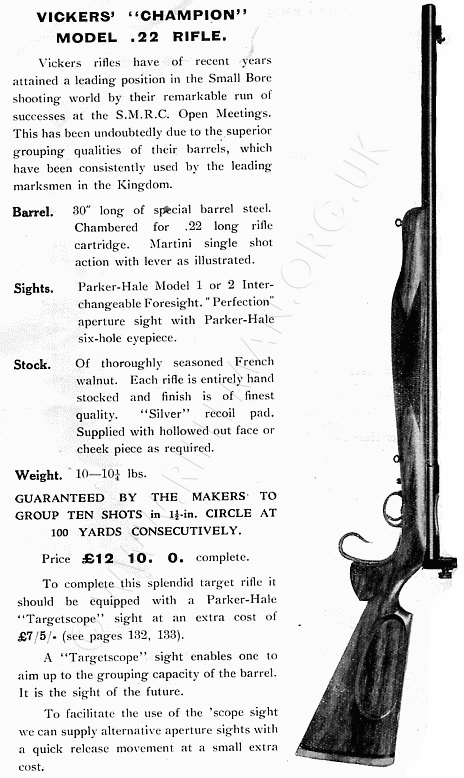
And their advertisement showing the three available stocking options
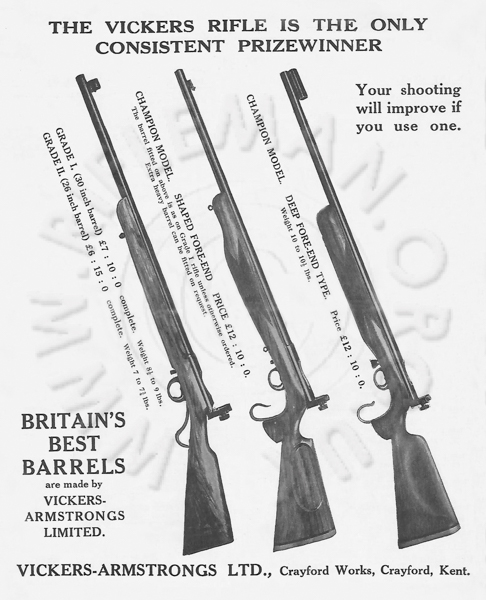
The complete action is easily removed from the receiver body for cleaning, in just the same way as the small-framed BSA Martini rifles. It should be borne in mind that the action locking screw is only that, it is not a barrel bedding screw (although we call it a bedding screw for identification purposes in the survey questionnaire, as it beds the action to the barrel from underneath). Some rifles will be found with that screw in the form of just an eye-bolt, non-too-easy to tighten and loosen without a spike of some kind or, when the head is slotted, a large screwdriver; whilst later models had a butterfly-key flange added to the sling hook eye to enable tightening and loosening by hand. Later models yet, including the Empire, had a similar key-like action-locking bolt passing through the side of the stock into the right-hand side of the front of the action body.
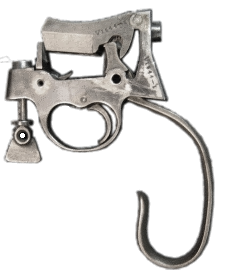 .............
.............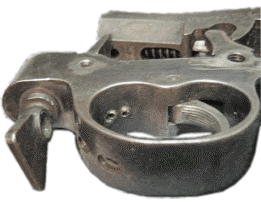
The image on the right clearly shows the trigger adjusting screws accessed via holes in the trigger guard. A configuration such as this was not even offered on the original BSA Martini International shortly after the War, but first appeared as original equipment on the Mark II International. It was also available as a retro-fit through agents such as A. G. Parker, A.J. Parker and Parker-Hale
The inventiveness of target shooters has always been worthy of note, and modifications to permit fine adjustment of trigger weight have been at the forefront of their attention, especially with Martini actions that are otherwise tricky to improve.
We came across this ingenious design to that end, applying a not dissimilar method to that which can occasionally be found on other .22RF Martini types, and formalised by the Parkers on the BSA models.
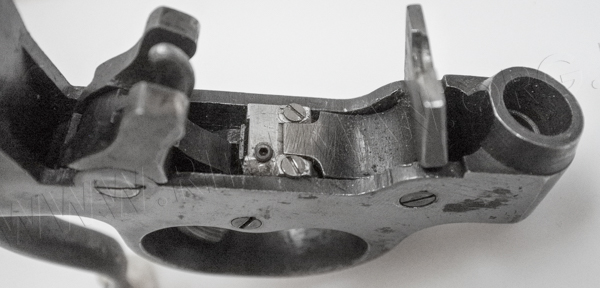
See page on the .22 MARTINI and the LEE-ENFIELD TRIGGER PULLS
Below: the stock fore-end of a Champion model.
This is the earlier model with a butterfly-key cum sling-eye action locking screw
that passes up through the action in front of the trigger-guard.
It is evident that the barrel's bedding is designed to be made on two points
that coincide with the front pair of machine-screws.
The barrel is does not bear evenly along the whole length of the fore-end,
but is fractionally relieved except for an inch or so either side of the bedding screw holes.
The lateral "bulged" shaping of the wood ahead of the hand-hold area can be clearly seen.

We have also obtained an original copy of the patent application for the Vickers small-bore Martini action,
the illustration from which is shown below.
Click on the image or here for the full text of the Patent Specification.
Below: the 1939 advertisement for the Vickers "Empire"
It should be noted that the Empire was available in either the basic straight-stocked form,
or in "Champion" configuration with custom stocking.
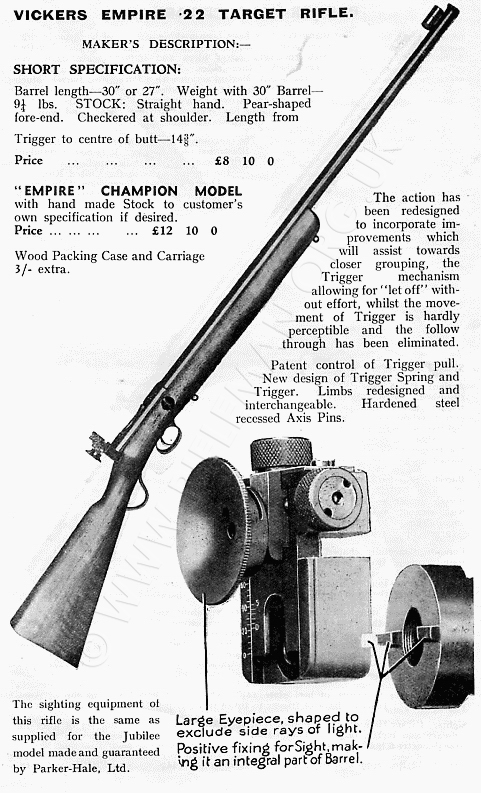
The Empire was available, as shown in the catalogue, in a standard form and as a Champion stocked special.
The "Empire" rifle in the 3D image below can be rotated through both axes by dragging your cursor left to right.
It can be zoomed and panned by clicking with the magnifier, and viewed full screen using the arrows top right.
Oddly, although this particular example of an Empire marked rifle has an "E" prefixed serial number stamped across the reinforce, the same number, only seen on the side of the action when removed from the rifle, is prefixed with an "S".
Other "S" prefixed rifles and actions are usually the Jubilee model.
The Empire "Champion" rifle in the 3D image below can be rotated through both axes by dragging your cursor left to right.
It can be zoomed and panned by clicking with the magnifier, and viewed full screen using the arrows top right.
And, next, an image of an Empire barrel from above,
showing the side locking bolt that is also to be seen in the advertisement above.
The 'E' prefix to the serial number 1908 is also evident, and the front of a Parker-Hale Quickloader is just in the picture.
It is worthy of not that the serial numbers of the Empire rifles were stamped laterally across the front of the barrel reinforce,
whereas the other rifles had the numbers stamped along the barrel low on one side or the other, ahead of the reinforce.
This rifle is held in the collection of the NRA Museum at Bisley by courtesy of J. Hallam
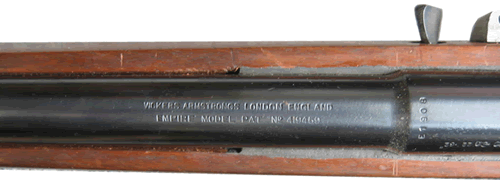
Since the invention of firearms, indeed weapons of any kind,
owners and users have spent time and funds on making improvements.
One of the most popular modification is to the wood furniture of a rifle to better the fit to its shooter.
A previous owner has 'bedded' this rifle's barrel with compound to improve accuracy,
and fitted a thumb-hole stock for a better 'hold'.

By courtesy of W. Landers, we can illustrate an example of exactly what the collector should be looking for.
This Empire Model is in as good a condition as you can hope to find more than sixty years after manufacture.
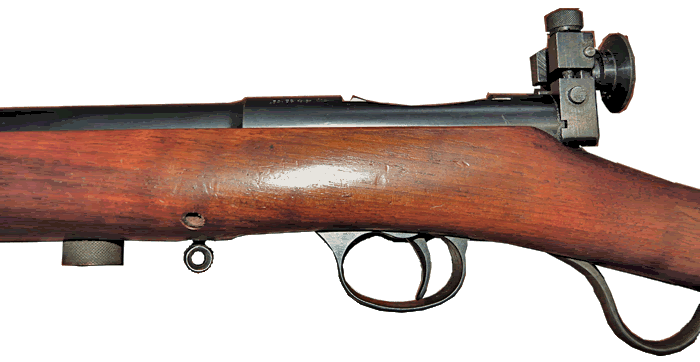
A previous shooter has fitted the screw-eye for the rear sling-hook slightly to one side, evidenced by the hole in the stock, an excellent way to help balance the sling's load on the rifle in the hold. With the sling hooked into an eye directly underneath the rifle, as here, there can be a tendency for the rifle to try to roll away from the shooters shoulder and clockwise of the palm of a right-hand shooter's holding hand under the fore-end. Only experimentation can decide what is best, and this has often resulted in empty holes over the stocks of old target rifles, particularly where a rifle may have changed hands several times over the course of its working life.
It is worth mentioning the fitment, under the fore-end ahead of the screw-eye, the cylindrical brass screw-on container for spare fore-sight elements. The later Parker-Hale No.2 tunnel fore-sight, and the BSA No.2 equivalent, with which many target rifles were retro-fitted or on which they became eventually offered as original equipment, used elements which could be easily changed over to suit the shooter or the targets being shot at. These can be seen in an advertisement at the last link for the BSA No.2 sight.

To find a rifle on which the top of the falling-block has not had the fine case-hardening colouring worn away by frequent loading is quite unusual, and an indication of how comparatively little use such a rifle has received.
Below is a facsimile of the 1934 catalogue for the Jubilee rifle.
Included are a number of double-page advertisements put out by Vickers
to publicise the considerable successes achieved by target shooters of the period with the company's rifles.
This is in the form of a text-searchable flip-page document
that may take a few moments to load.
Double tap tablet or click ![]() for full page display.
for full page display.
And, in the same year as the Empire was advertised (1939), an advertisement for the Vickers "Jubilee" model
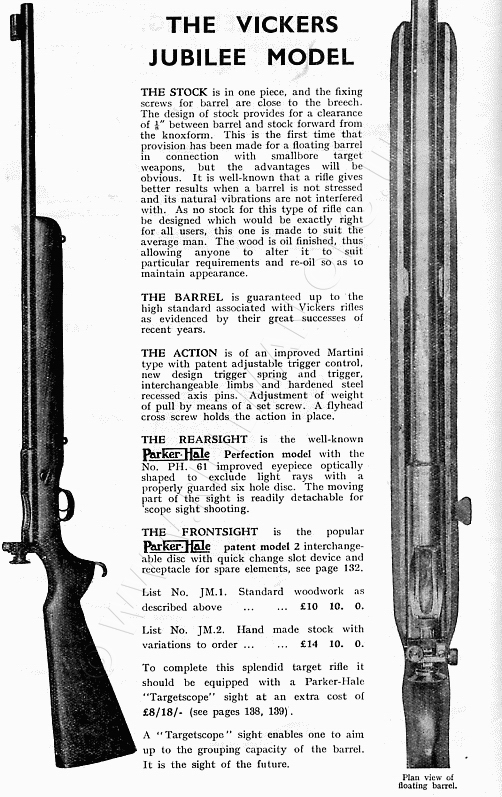
We discuss more of the Jubilee model later, but note the significant clearance between the barrel and fore-end wood,
and the single pair of bedding points about a third of the way along the barrel.
To assist in the identification of the various models we have taken photographs of the six main actions and receivers.
Firstly: the receivers from above.
The rifles are in our estimated order of date manufacture from right to left.
The differences in design are here more obvious.
The variance in receiver/action dimensions measured as,
from the rear of the falling-block backplate to rear-sight - right to left;
the Mark I rifles - 1 inch
the Mark II and early Champion - ½ inch
the Empire rifles - ⅝ inch
From the RIGHT: Mark I; early Mark II; later Mark II; early Champion; standard Empire; Empire-Champion.
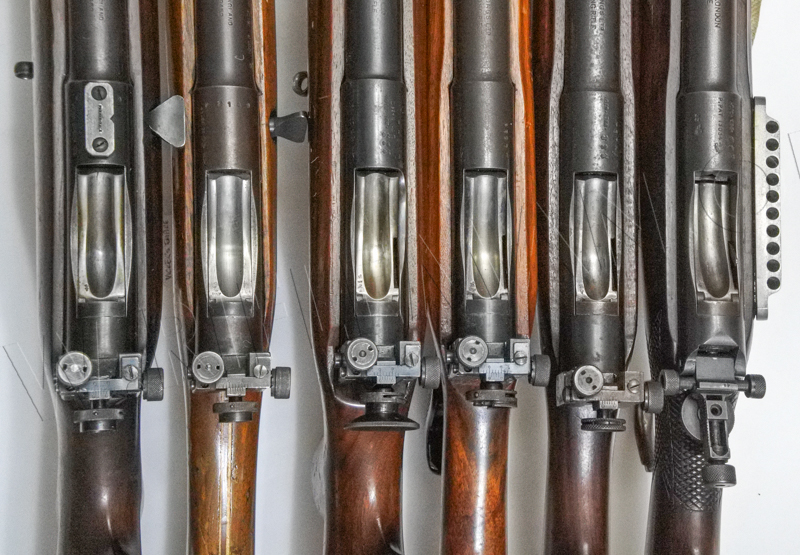
Below: the top left action is of the Mark I, the top right is of the early Mark II.
The centre action is of the early Champion model.
The bottom left unit is from the Empire Champion rifle,
and the bottom right of the standard Empire model.
The Jubilee rifle is treated separately shortly, but the Jubilee and Empire actions are ostensibly the same.
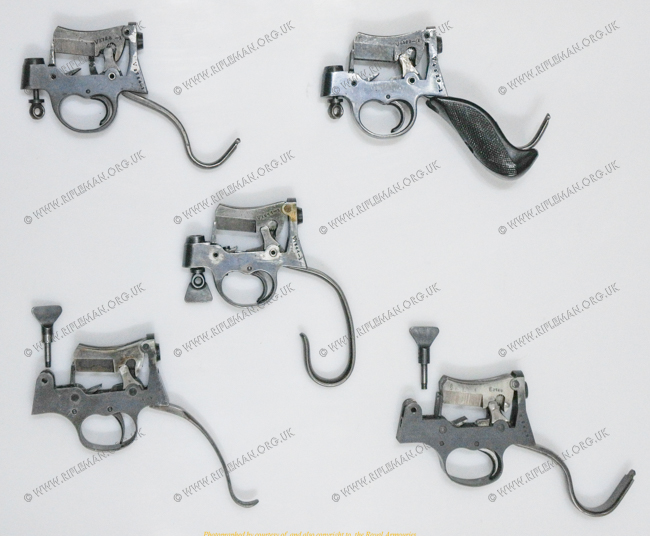
We reproduce below, the five page small-bore section of Vickers' own catalogue of 1923
This is in the form of a text-searchable flip-page document
that may take a few moments to load.
Double tap tablet or click ![]() for full page display.
for full page display.
Below, the "Perfection" rearsight with the clearance hole for a cleaning rod
to be applied at the breech-end;
see the Mark II and Champion rifles illustrated above.
The sight usually carries, on the right-hand side, the
design number "RD. 729118".
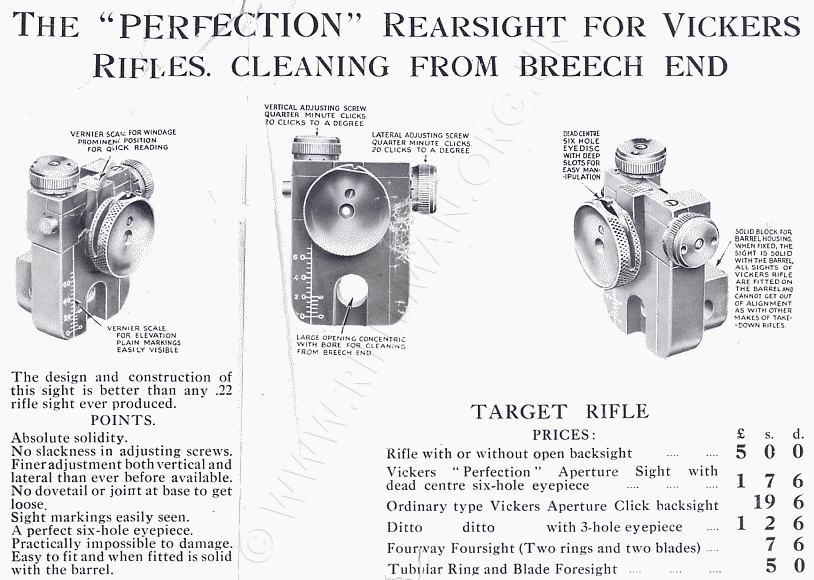
Not all Perfection rear-sights are as heavily radiused at the bottom corners of the main body
as those in the advertisement above, many have a much smaller radius,
and indeed some are almost squared at these corners.
Below, the earlier folding rear sight fitted to the Mark I rifle shown above.
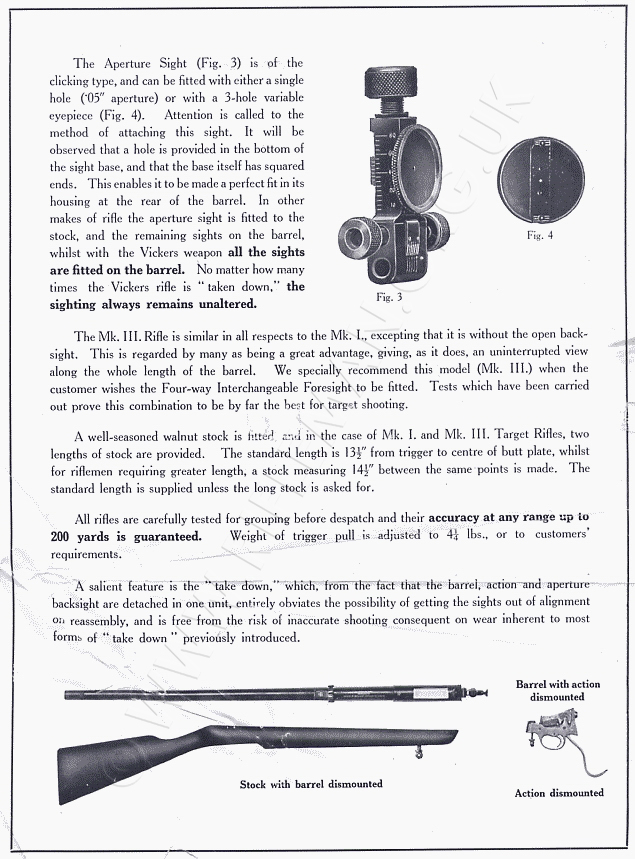
A little way outside our remit, but worthy of mention,
the sporting rifle was effectively the target rifle
minus the aperture rear-sight and with a tapered barrel and a shortened fore-end.
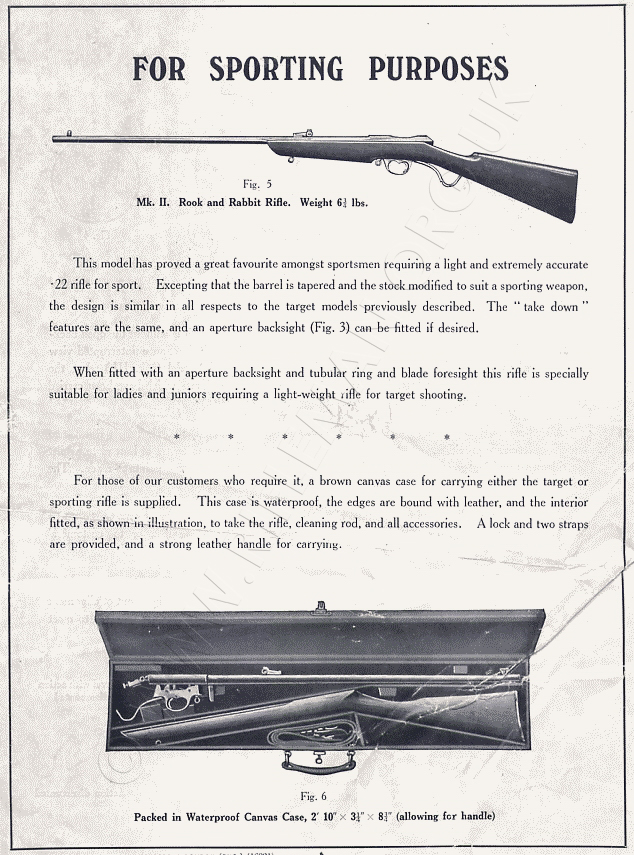
Finally, apologies for the poor reproduction of this facsimile
of an American advertisement for the Jubilee model
and the specially "Stoeger" stocked Olympic Match rifles,
but this page would not be complete without mention particularly of the Olympic version.
(We copy most of the text below it in coloured italics).
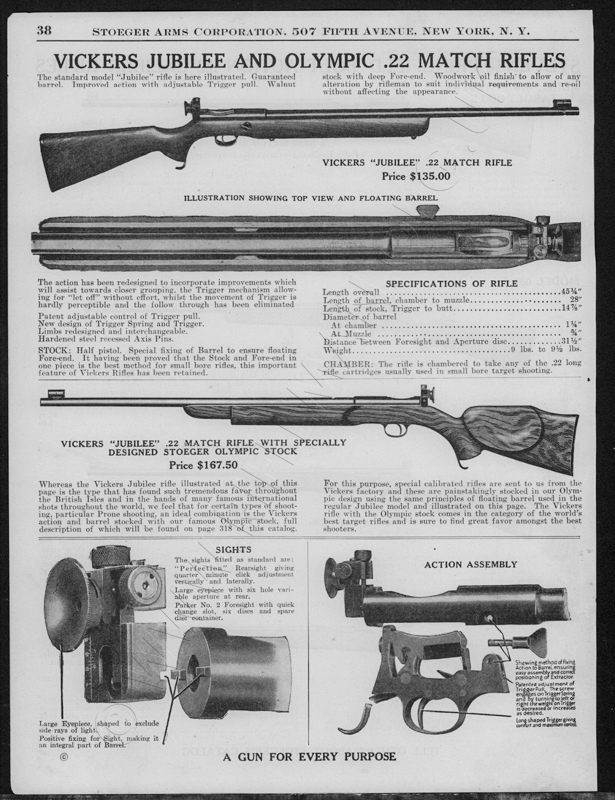
The lower right section on the action notes -
" Redesigned and interchangeable hardened steel recessed axis pins"
An important point that will be mentioned again later
is the squaring-off of the front of the action frame,
compared with the rounded nose of the earlier models.
VICKERS JUBILEE AND OLYMPIC .22 MATCH RIFLES
" The standard model "Jubilee" rifle is here illustrated. Guaranteed barrel. Improved action with adjustable Trigger pull. Walnut stock with deep Fore-end. Woodwork oil finished to allow of any alteration by rifleman to suit individual requirements and re... without affecting appearance.
VICKERS "JUBILEE" .22 MATCH RIFLE
Price $135.00
The action has been redesigned to incorporate improvements which will assist towards closer grouping, the Trigger mechanism allowing for "let-off" without effort, whilst the movement of Trigger is hardly perceptible and the follow through has been eliminated.
New design of Trigger spring and trigger
L... redesigned and interchangeable
Hardened steel recessed Axis pins
_______________________________
SPECIFICATIONS OF RIFLE
Length overall ..................................................... 45.."
Length of barrel, chamber to muzzle ................. tba
Length of stock, Trigger to butt ......................... 14⅜"
Diameter of barrel
... at chamber ...................................................... 1.."
... at muzzle ......................................................... 1.."
Distance between fore-sight and aperture ...........31 ."
Weight ............................................... 9 lbs. to 9½ lbs.
CHAMBER: The rifle is chambered to take any of the .22 Long Rifle cartridges usually used in small-bore target shooting. For this purpose, special calibrated rifles are sent by us from the Vickers factory and these are painstakingly stocked in our Olympic design using the same principles of floating barrel used in the regular Jubilee model and illustrated on this page. The Vickers rifle with the Olympic stock comes in the category of the the World's beattarget rifles and is sure to find great favour amongst the h... shooters.
STOCK: Whereas the Vickers Jubilee rifle illustrated at the top of this page is the type that has found such tremendous favour throughout the British Isles and in the hands of many famous International shots throughout the World, we feel that for certain types of shooting, in particular prone shooting, an ideal combination is the Vickers action and barrel stocked with our famous Olympic stock, full description of which will be found on page 318 of this catalogue.
SIGHTS: The sights fitted as standard are "Perfection" rear-sight giving quarter minute click adjustment vertically and laterally.
Larger eyepiece with six hole adjustable aperture at rear.
Parker No.2 fore-sight with quick change slot, six discs and spare disc container."
______________________________
The Jubilee rifle in the 3D image below can be rotated through both axes
by dragging your cursor left to right.
It can be zoomed and panned by clicking with the magnifier,
and viewed full screen using the arrows top right.
The 1935 advertisement in the SMRC's journal 'The Rifleman' gave comprehensive detail of the new improvements brought in with the Jubilee model, including the important addition of trigger pull weight adjustment, accessed via an adjusting screw set into the squared-off nose of the new action block.
The illustrations also show the srelied slots in the side of the receiver to accommodate the front lugs of the action through which the side mounted butterfly-key action locking pin passes.
There is now specific mention of the fore-end clearance in the paragraph
"STOCK - Half pistol. Special fixing of Barrel to ensure floating fore-end. It having been proved that the Stock and Fore-end in one piece is the best method for small-bore rifles, this important feature of Vickers Rifles has been retained".
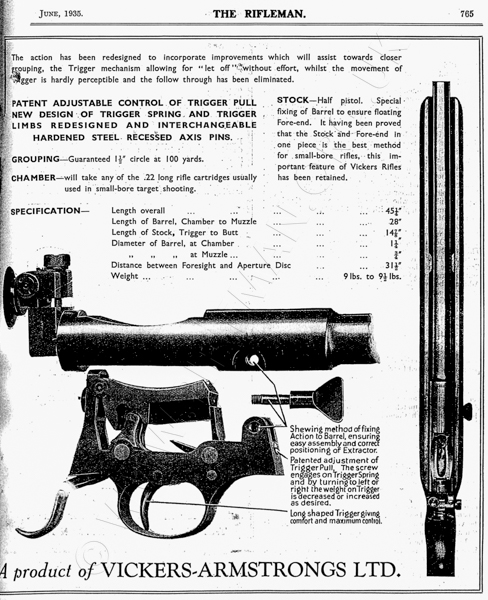
The specification gives the overall length as 45½" inches, the barrel as 28",
the pull as 14½", and the weight as being between 9 and 9.5 lbs.
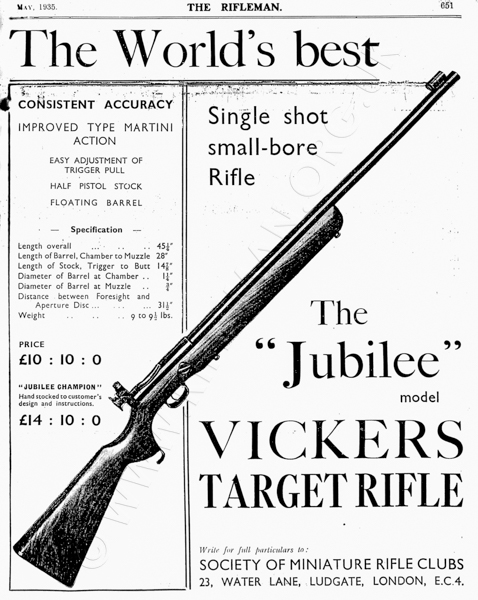
The 1935 price for a standard Jubilee rifle was ten guineas (ten pounds and ten shillings -
- equivalent to about seven hundred pounds in 21st. Century terms).
The specially stocked Champion version was nearly 40% more, at £14:10:0.
An indication of relative inflation, between the 1930s and now,
is that the 1939 prices given in the advertisement shown earlier on this page are unchanged.
This situation has rarely been seen eighty years on.
The particular Jubilee rifle which is the subject of our page
has the only composite butt-plate we have yet seen,
with moulded chequering, and the interlaced "V/A" cartouche of Vickers Armstrongs.
The butt carries an engraved plate for the Chobham & District Rifle Club,
and the rifle was evidently in that club's armoury for general use by the membership.
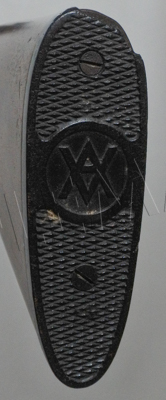 .............................
............................. 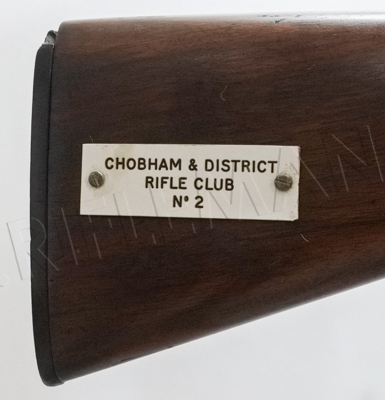
The square-nosed action of the Empire and Jubilee rifles, with the side-locking butterfly screw,
is illustrated from above and below;
and beneath are the equivalent views of the earlier round-nosed action,
with the "up-and-under" locking screw, for comparison.
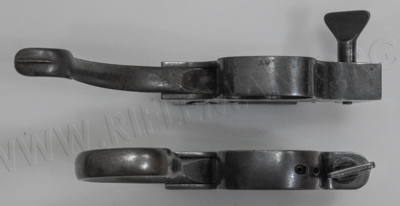 ......
...... 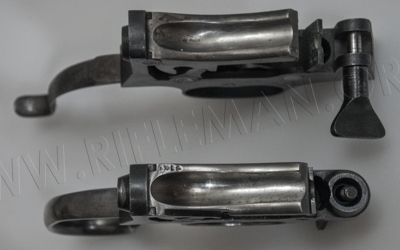
The same actions are now illustrated in side elevation,
showing a number of differences, including the locating stud's form at the rear of the frame,
and the falling block of the Jubilee without the milled groove that would have taken a cocking indicator.
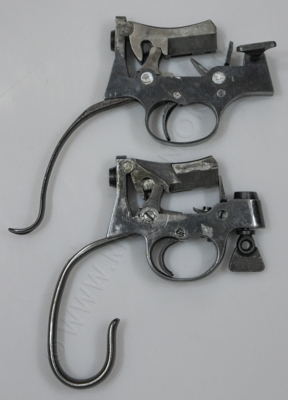
Various of these later models incorporated different bedding arrangements,
and we hope to eventually be able to identify which methods were used on which rifles, and at what point in time.
The employment of what could perhaps be called a semi-floating barrel appeared with the Jubilee model,
and, as can be seen in the 1935 and 1939 advertisements already shown,
one system used a single bedding point 6⅛ inches ahead of the rear bedding screw,
the latter screw effectively pulling down the front of the 'receiver's' forward section,
which also doubles as the barrel reinforce.
The fore-ends of the two rifles below have significant clearance all along the fore-end wood,
compared with the plain full-length bedding of the Mark I and Mark II rifles.
We have seen that the early Champion models have witness marks only at the bedding screw points,
indicating that the fore-end groove was fractionally relieved all along
except for an inch either side of the bedding screws.
But these later rifles show much more obvious raised bedding points.

Above: top; is the Jubilee stock, with the one central barrel bedding point,
the rear screw's bedding being under the front of the 'receiver' section
behind the shoulder of the barrel's 'reinforce'.
Underneath that is the earlier champion-style stock, with the 10 inch spaced barrel bedding points.
The 'reinforce' shoulder can be seen to be further back,
so that the rear bedding screw is actually threaded into the barrel
rather than into the parallel rounded 'receiver' section.
Below: the same two stocks shown with the barrels fitted.
The additional length of the 'receiver' section ahead of the falling block
of the Jubilee rifle at the top is very obvious.
This permits the rear bedding screw to draw down the parallel part of the body
leaving just the one screw 6⅛" further forward for the barrel itself.
As mentioned, the earlier Champion style rifle at the bottom
has both 10" spaced bedding screws pulling down the barrel,
with the rear screw being 1½ inches forward of the shoulder of the 'reinforce',
and there is no draw-down on the parallel rear section behing the shoulder.
This is doubtless why a third fastening was added at the very rear
of the body of the Vickers Walker rifle.

One more interesting custom-stocked rifle has been brought to our notice,
but we have no information on its model,
although it appears to be the equivalent of an early Champion rifle
built on the Mk.II long-barrelled ironwork.

It therefore has the two 10" spaced bedding screws into the barrel, and an additional screw passes right through the stock ahead of the action, with an sling-eye on the left-hand-side, and a rather aesthetically despoiling nut countersunk on the right.
Although structurally thoroughly sound, I doubt if its additional secuity over the more usual wood-screw-eye is worthwhile, and the presence of this fitting is rather a shame, in view of the beautiful work that has been done by a professional stocker.
The sling-eye is also unusually high, adding a significant turning moment to the hold, at the same time reducing the downward tension on the rifle.
Nonetheless, the stock is one of the finest to be seen on any rifle, with finger-grip grooves to the right for its right-handed shooter (reminiscent of the similar style of hand-grooving on the trials Pattern '13 Enfield Rifle), and a thumb depression on the left that has been unusually "chequered" with a 'rough wood grain' design that is carried over from the work on the pistol-grip and wrist.
Beneath the swell of the hand-hold is a finely carved 'fleur-de-lys' emblem, and there is much other fine scroll and profiling work encompassing the wrist and pistol-grip.

Should you know anything of this rifle, we would be delighted to hear of it - to be able to tell more to our readers.
To expand on all that has been covered thus far, and to perhaps assist at least somewhat with everyone's wish to correctly identify and date their own rifle, some supposition has been made regarding Vickers' small-bore rifle production. This supposition is likely to be correct, in part if not wholly (time may tell), and can perhaps be expanded upon in the future.
We are aware that most "Mk.I" rifles, with the folding rear aperture sight pivoted on the action, seem to be those prefixed "V", whilst the later mark of Standard Vickers .22 target rifles, the models with the "Perfection" rear-sight, appear to be "L" prefixed, as too does the "Champion" model. However, it is evident that some of the later 'V' prefixed serialled rifles have the Perfection sight fitted. The Standard Match Rifle Mk.I came with the original open tangent back-sight as well as the folding rear aperture-sight.
Oddly, their Mk.III model (available in 1925) was the same rifle, sold without the barrel mounted open sight, and entitled the Match Rifle, Mk.III. Incidentally, the Mk.II Vickers was their 'Rook & Rabbit' sporting version, advertised in 1924, with a tapered barrel and open sights only; but this same model, when fitted with the folding rear aperture-sight, was recommended as a target rifle suitable for "Ladies and Juniors". The Champion rifle has metalwork identical to the Standard rifle, but is fitted with Vickers' "special" barrel - one selected for best accuracy - (1.5 inch group or better at 100 yards), as well as the special pistol-grip stocking with swollen fore-end and forward curved under-lever for rapid fire. One later Standard model rifle we know of is numbered in the range "L 45**" (in the batch with the factory-raised comb), whilst a known Champion model is serialled in the "L 15**" range.
The Olympic model, of around 1924, is another rifle of similar configuration; i.e. Standard ironwork and Special barrel, but with a special target stock designed by STOEGER along the lines of the Champion. The Jubilee model is another consideration here, and is the one advertised as a custom option, in terms of stocking to client's specification. In 1935 a " Jubilee Champion" model was advertised with the custom stock option.
In addition to the "E" presumed to be for the Empire model, and seemingly confirmed by several auction catalogue entries specifically naming this rifle model with such serial numbers, there is also an "S" prefix which appears on notes of three Jubilee models. All of these are in the series S 1***.
One "B" prefixed rifle has been recorded, but this could be a typographical error. On the other hand it might be for a sporting rifle or even an Olympic model; we have yet to see one of the latter to check. There is another possibility we will mention shortly.
If anyone has an "E", "S" or "B" prefixed rifle (or indeed one without a prefix), we too would be grateful for any further details. We have for some time mooted starting a survey along the lines of the one for the War Office Miniature rifle already on the website. That is itself slowly building up to give a more accurate idea of date of manufacture against specification and serial number. It would be very useful to confirm the supposed significance of the Vickers' prefixes, and to attach the "B" to a particular model if it really exists. Also, are there really any non-prefixed numbers, or have prefixes simply been omitted from catalogued serial numbers? Could we then make better estimates of production numbers from serial ranges? Are there any numbers below 1000? What are the highest numbers in each range?
Well that survey is now commencing as of September 2020,
and will only build into a worthwhile reference facility with your input.
Please see our SURVEY DATA TABLE
Presently, the highest "V" I have come across is 9881, and the highest "L" is 9417. One reported 'sans-prefix number' is 17**. There is a supposed "E" prefixed Empire model, in one catalogue, with a serial number of 21313. I treat this with a degree of caution, not least because Weller & Dufty catalogues are littered with such 'typos'. It is a not impossible number, with other models certainly approaching the tens of thousands; but the Empire is the more rare model, and all other such serial numbers seen are in the "E 2***" range only, which begs the questions ..... did all Vickers ranges commence at 1000, or perhaps did the "E" models commence at 2000, and, as already mentioned, were there any numbers - even non-prefixed - less than 1000? Perhaps any proud owners out there could advise accordingly.
The only presently noted "B" prefixed number is "1405-3", which raises a further query regarding Vickers' serials. Quite a number of rifles carry a '1' or '2' suffix, and I have hitherto presumed these to refer to the grade of the rifle, '1' being the grade for the 30" barrelled rifle with Vickers' later specification nickel steel, whilst '2 'was for the 26" barrelled rifle to their earlier 1929 spec. The former probably meeting the 1.5 inch group, but the latter guaranteed only for a 2" group at 100 yards.
The appearance of a '3' suffix had confused the issue, until we discovered, in a 1931 SMRC handbook, an advertisement for Grade 3 Vickers rifles acquired by the Society as being Vickers' "whole stock" of same. These rifles were offered to the membership for £4-4s-0d; a considerable discount, upon the Grade 1 price at the time, of two guineas on the usual figure of 6 guineas. A testament made by one of the purchasers, a member of the West Hartlepool Royal British Legion club, states that his average rose from 91 to 96 after the acquisition - but he fails to mention which rifle he was using previously! He sent in his first ever 'possible' card to the SMRC .............. and predictably asked for it to be returned. Perhaps the "B" referred specifically to this batch of rifles, which may have been held back by the factory, when failing to meet their preferred minimum accuracy, and subsequently sold off as 'thirds'. That these rifles still performed adequately for some of their clientelle is evident. It is worth mentioning that, in years past, we have had some of our own best scores, in various historic small-bore rifle competitions, with our Vickers rifles; itself testament to the quality of their barrels, since these have not been Parker-rifled .... although neither are they suffixed with even a '2', let alone a '3'.
Let's look forward to more information being brought forth, even if our supposition is disproven by someone.
We have alluded to the means by which a rifle can possibly be dated,
and the subject is dealt with on our page "Dating your Rifle".
As an example of how this may be done we separated the barrelled action
from the wood furniture of the Mark I rifle shown on this page.
The photographs below illustrate the stampings that offer the information sought.
.jpg) ...............................
............................... .jpg)
Left: the date stamp of the Proof House is that immediately to the left of the shoulder of the barrel reinforce.
Right: an enlargement of that mark, showing the "K" representing the year period 1931-1932.
Whilst this gives the date of proof, the stamping to the very left of the right-hand image is of the number "29",
above an "X", and there is a very good chance that this may indicate the year of the barrel's manufacture.
As mentioned, the listing of date codes is available from the link above.
The Vickers Armstrong Company produced their own in-house newsletter, which provided information of the Company's projects for staff, as well as affording a forum for their social activities. The factory at Crayford in Kent was often represented in articles dealing with both those products manufactured in that plant, including huge presses built under license to an American company as well as the small-bore rifles, and the activities of the staff themselves - both social and sporting.
Below are copied three articles from that Armstrong-Vickers Monthly News; a publication for staff consumption only. Bear in mind that the company had works and factories Nation-wide, and manufactured considerable quantities of war materiél, including large surface warships, submarines, aircraft, armoured and other vehicles, as well as both heavy and light armament. They wanted their workers to appreciate what they were collectively achieving, but also to encouraged them to engage in the many sporting and social activities for which assistance and facilities were provided by the Company in a fashion nowadays often lost to employees of large companies, whose social expenditure has been slashed by the pens of accountants in the name of the shareholders.
It was obviously to the Company's advantage to publicise the successes of those staff members who shot Vickers' rifles, and much was made of one young man who, over the course of a couple of years, went from a tyro to a most competent class-winning shot. Unsurprisingly, Vickers were proud of successes attained by the users of their rifles world-wide, and noted every such event in both their internal and external publicity material. International wins were. of course, paramount.
In July 1933, Vickers put the following piece into their journal.
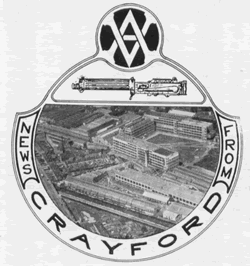
THE SMALL BORE RIFLE
CRAYFORD WORKS OF VICKERS-ARMSTRONGS LIMITED
"At the International Rifle
Meeting, held at Granada, South Spain, during the early part of June, Great
Britain Was represented by a team consisting of the most skilled small-bore
shots in this country. Such team had to compete against picked marksmen from
almost all the European countries, each team being anxious to win the team
event, and each individual being equally anxious to secure the Blue Riband
of small-bore shooting, carrying with it the title of the World's Champion.
It is pleasing to know that of the five men selected to shoot for Great Britain,
no less than four used the Vickers weapon, and although the team secured third
place, such performance is creditable in view of the conditions under which
the matches were held. Our men found the heat extremely trying, and, in addition,
they had to shoot on the Continental targets, which are quite different from
those in use in this country. They used the standard rifles as allowed in
competition in England, whereas the Continental competitors had the advantage
of two-trigger rifles, peculiar to Continental shooting and particularly adapted
for use with the Continental targets.
The placings of the first three teams in the event were :
1. Sweden.
2. Finland.
..........3. Great Britain.
there being only two points between second and third place.
The individual championship was secured by Mr. H. S. Longhurst, and the third
place by Mr. F. S. Morse, both well-known members of the British small-bore
movement and both confirmed users of the Vickers weapon.
Mr. H. S. Longhurst, the new World's Shooting Champion, has won the championship
of Great Britain on two occasions, in 1921 and 1929, and has been prom¬inent
in almost all competitions during the past two years. He has regularly shot
for Great Britain in Inter¬national teams against America and other countries,
and has maintained consistent super accuracy unparalleled in the sport of
Small Bore Rifle Shooting.
Crayford Works is particularly proud of this wonderful achievement. It sets
the capping stone on the brilliant series of successes obtained by the Vickers
Rifle during the past four years.
Our readers will perhaps remember that in our issue of October, 1931, an article
appeared under the above heading which gave some idea of the successes obtained
by the users of the small bore rifle manufactured at our Crayford Works. Since
that date the record of the rifle has been one of almost continuous success.
At the National Meetings, held in 1932, all the premier events were secured
with the aid of the Vickers Rifle, and in the International event against
U.S.A., Canada, Australia and South Africa, of the members of the team shooting
for Great Britain those using the Vickers weapon secured all the top places.
Although this year's outdoor shooting season has only recently opened, it
is pleasing to know that the record of successes still maintains.
Small bore shooting is becoming increasingly popular and the skill of the
present-day marksman is such as to necessitate continual progress on the part
of manufacturers of both rifles and ammunition.
Our Crayford friends have this matter well in hand and are already at work
on improvements to the Vickers Rifle, which will make it even more popular."
The August and September issues of their not insignificant journal, were respectively reported the World Championship being won by Henry Longhurst with one of their target rifles, which appears to be a Champion Model illustrated with the text below, and the following month reported inter-company competitions results and the remarkably swift progress of a young Crayford Works staff member who had started shooting only a year earlier, seemingly with a standard rifle.
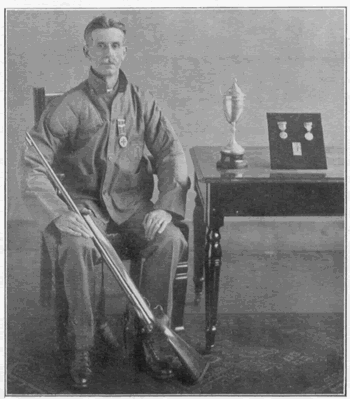 We
give a photograph of Mr. H. S. Longhurst who, as mentioned in the July issue
of this Journal, won the World's Championship for small bore shooting in the
prone position at the International Rifle Meeting held last month at Granada,
Spain.
We
give a photograph of Mr. H. S. Longhurst who, as mentioned in the July issue
of this Journal, won the World's Championship for small bore shooting in the
prone position at the International Rifle Meeting held last month at Granada,
Spain.
Mr. Longhurst has been a confirmed user of Vickers' Rifles for a considerable
number of years, and during that period has had a most remarkable series of
successes.
At the recent Bisley Meeting which concluded on Saturday, 15th July, Mr. Longhurst
won the " Sunday Times " Challenge Cup with the high score of 399.8,
the shooting being one card each at 25 and 50 yards, and two cards at 100
yards.
He also won the Grand Aggregate at the same Meeting with a record score of
1392.3.
Mr. Longhurst is considered to be one of the most consistent shots in the
world, and Crayford Works are extremely proud of the continued successes which
he obtains with their " small bore rifle."
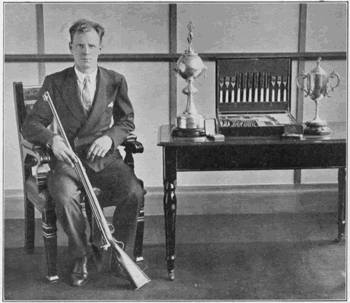 Rifle Section
Rifle Section
There is very little to report this month, as since the Bisley meeting things
have been moving slowly, and the only shoot of importance was the tenth round
in the National League against Belfast. T he official result of this match
is to hand, and we succeeded in maintaining our unbeaten record by 15 points-
1761 to 1746.
On Sunday, 30th July, we fired a friendly post match against the I.C.I., and
suffered defeat by four points. The secretary of the 1.C.1. club has expressed
a wish for a return match, but our team favour a shoulder to shoulder shoot..
The activities of our young member, Mr. J. Trenamen, were fully described
in the last issue, and it only remains to be said that there is every chance
for other new members to prove their ability by the time another Bisley meeting
comes along.
The accompanying photograph shows Mr. Trenamen with his trophies, to which
reference was made in the August issue.
It is rather pleasing to see some fresh faces at the range, and we should
have a good team to contest the London Business Houses League in the winter.
There are still a number of enquiries from members of the " Y.C.D."
club as to the cost of the Rifle Section, and although it has been published
frequently in this journal, it will perhaps be as well to repeat, that every
full sub¬scriber is entitled to the use of the range and the club rifles.
From the numbers employed at the Crayford and Hartford Works, there should
be sufficient good shots to form one of the best teams in the country.
The rifles in use are of first class quality, and the tuition and coaching
all that can be desired.
Already shown in one of the catalogue facsimiles,
we finish with images of four pages from a Vickers leaflet of 1935, showing the Crayford, Kent, address for the factory at which the small-bore rifles were produced. Much else was made there, including enormous presses for such purposes as car parts manufacture, and specialised canning machinery, some built under licence from the American company "Bliss".
The Vickers company was not backward in publicising the successes of their rifles in competition. One page trumpets the World record score achieved by the renowned E.G.B. Reynolds (author of the post-war premier reference book for the Lee-Enfield Rifles - (see Bibliography) in the Dewar International event.
Vickers rifles proved very successful in capable hands, and were evidently a match for the ubiquitous B.S.A. products.
But this success was maintained only over a comparatively few short years,
compared with the many decades during which B.S.A. managed to keep their target rifles
in the top flight of World small-bore shooting.
The third page puts forward a boast that the Vickers rifle will be competitive using any ammunition, recording wins with Nobel, I.C.I. ( Imperial Chemical Industries) and Palma cartridges. Certainly the consecutive 1st. to 7th. placings for their rifles in the Bell Trophy competition were impressive, and results in the I.C.I. competition lose out only to another unmentioned manufacturer's rifle in fourth place, and all with either I.C.I.'s own or Nobel ammunition.
The fourth page records Vickers successes both in 1935, and between the years 1929 and 1934, with first or first equal placings every year for their rifles in the Earl (Lord) Roberts Annual National Championship, which to this day remains the event in which every dedicated British small-bore rifle shooter aspires to attain the tremendous recognition afforded to the top scorer, not to mention the magnificent trophy, the Lord Roberts Cup.
Should you have own one of these small-bore Vickers rifle models,
please see our page seeking data for our Survey
See also the Vickers-based "WALKER" PRESENTATION RIFLE of 1935 
Not really part of our remit, but of interest to some readers,
we illustrate a further searchable facsimile,
of Vickers' 1930s catalogue for their Sporting Guns and Rifles.
In addition to their .22 rifles are included a .318" calibre rifle,
a .403" calibre rifle and, on the very last page,
an interesting .300" Sherwood Martini actioned rifle,
of "Rook and Rabbit" style,
built on a similar action to that of the .22LR rifles.
This may take a few moments to load.
As a closing footnote for these fine Vickers rifles, an advertisement appeared
in the March 1949 issue of the Journal for the National Smallbore Rifle Association,
(previously the S.M.R.C.,)
offering to members the very last dozen rifles from all of Vickers production,
These were Empire models, with sights at £25.
These rifles have appreciated somewhat over the years with inflation,
but are still not over expensive for shooters and collectors,
and continue to offer considerable fun ,with accuracy, to their proud owners.
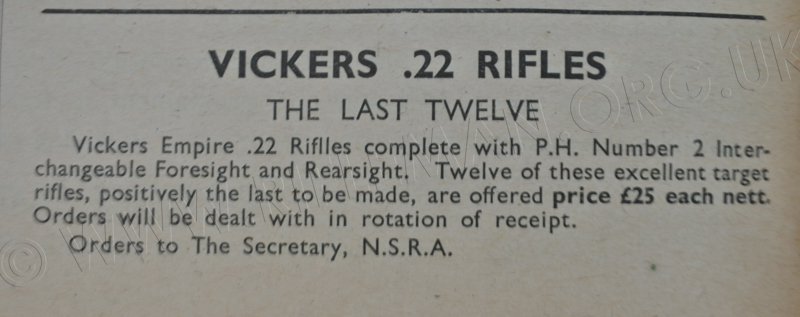
A comprehensive timeline of the various Vickers associated companies is to be found HERE (External Link)
Return to: TOP of PAGE
See this website's Raison d'être
